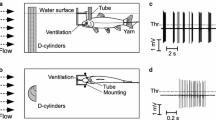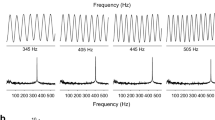Abstract
Fish use their mechanosensory lateral line amongst others for the detection of vortices shed by an upstream object and/or for the detection of vortices caused by the tail fin movements of another fish. Thus, vortices are one type of hydrodynamic stimuli to which fish are exposed in their natural environment. We investigated the responses of medullary lateral line units of common rudd, Scardinius erythrophthalmus, and common nase, Chondrostoma nasus (Cyprinidae), to water flow (9.5–13.3 cm−1) that contained vortices (a Kármán vortex street) shed by an upstream cylinder (diameter 2 cm). The distance between the cylinder and the tip of the fish’s snout varied between 8 and 24 cm. 21 out of 42 units (S. erythrophthalmus), respectively, 9 out of 39 units (Chondrostoma nasus) responded to the vortices shed by the cylinder. Up to a cylinder distance of 24 cm, interburst intervals revealed the vortex shedding frequency, i.e., burst frequency was similar to or identical with the vortex shedding frequency.











Similar content being viewed by others
Abbreviations
- CN:
-
Canal neuromast
- MON:
-
Medial octavolateralis nucleus
- Pdf:
-
Probability density function
- PIV:
-
Particle image velocimetry
- RF:
-
Receptive field
- SN:
-
Superficial neuromast
- VSF:
-
Vortex shedding frequency
- VSD:
-
Vortex shedding delay
References
Beckmann M, Erős T, Schmitz A, Bleckmann H (2010) Number and distribution of superficial neuromasts in twelve common european cypriniform fishes and their relationship to habitat occurrence. Int Rev Hydrobiol 95:273–284
Bleckmann H (1988) Prey identification and prey localization in surface feeding fish and fishing spiders. In: Atema J, Fay RR, Popper AN, Tavolga WN (eds) Sensory biology of aquatic animals. Springer, New York, pp 619–641
Bleckmann H (2008) Peripheral and central processing of lateral line information. J Comp Physiol A 194:145–158
Bleckmann H, Mogdans J (2014) Neuronal basis of source localization and the processing of bulk water flow with the lateral line. In: Bleckmann H, Mogdans J, Coombs SL (eds) Flow sensing in air and water. Behavioral, neural and engineering principles of operation. Springer, Berlin, pp 371–398
Bleckmann H, Zelick R (1993) The responses of peripheral and central mechanosensory lateral line units of weakly electric fish to moving objects. J Comp Physiol A 172:115–128
Bleckmann H, Weiss O, Bullock TH (1989) Physiology of lateral line mechanoreceptive regions in the elasmobranch brain. J Comp Physiol A 164:459–474
Breder CM (1965) Vortices and fish schools. Zoologica 50:97–114
Burt de Perera T (2004) Fish can encode order in their spatial map. Proc R Soc B Biol Sci 271:2131–2134
Chagnaud BP, Bleckmann H, Engelmann J (2006) Neural responses of goldfish lateral line afferents to vortex motions. J Exp Biol 209:327–342
Chagnaud BP, Bleckmann H, Hofmann MH (2007a) Kármán vortex street detection by the lateral line. J Comp Physiol A 193:753–763
Chagnaud BP, Hofmann MH, Mogdans J (2007b) Responses to dipole stimuli of anterior lateral line nerve fibres in goldfish, Carassius auratus, under still and running water conditions. J Comp Physiol A 193:249–263
Chagnaud BP, Bleckmann H, Hofmann MH (2008a) Lateral line nerve fibers do not code bulk water flow direction in turbulent flow. Zoology 111:204–217
Chagnaud BP, Brücker C, Hofmann MH, Bleckmann H (2008b) Measuring flow velocity and flow direction by spatial and temporal analysis of flow fluctuations. J Neurosci 28:4479–4487
Coombs S, Janssen J, Webb J (1988) Diversity of lateral line Systems: Evolutionary and Functional considerations. In: Atema J, Fay R, Popper A, Tavolga W (eds) Sensory biology of aquatic anmals. Springer, New York, pp 553–593
Dehnhardt G, Mauck B, Hanke W, Bleckmann H (2001) Hydrodynamic trail-following in harbor seals (Phoca vitulina). Science 293:102–104
Dehnhardt G, Hanke W, Wieskotten S, Krüger Y, Miersch L (2014) Hydrodynamic perception in seals and sea lions. In: Bleckmann H, Mogdans J, Coombs SL (eds) Flow sensing in air and water behavioral, neural and engineering principles of operation. Spinger, Berlin, pp 147–167
Dowben RM, Rose JE (1953) A metal-filled microelectrode. Science 118:22–24
Engelmann J, Bleckmann H (2004) Coding of lateral line stimuli in the goldfish midbrain in still and running water. Zool 107:135 – 51
Engelmann J, Hanke W, Mogdans J, Bleckmann H (2000) Hydrodynamic stimuli and the fish lateral line. Nature 408:51–52
Engelmann J, Hanke W, Bleckmann H (2002) Lateral line reception in still- and running water. J Comp Physiol A 188:513–526
Engelmann J, Kröther S, Bleckmann H, Mogdans J (2003) Effects of running water on lateral line responses to moving objects. Brain Behav Evol 61:195–212
Faucher K, Parmentier E, Becco C, Vandewalle N, Vandevalle P (2010) Fish lateral system is required for accurate control of shoaling behaviour. Anim Behav 79:679–687
Hanke W, Bleckmann H (2004) The hydrodynamic trails of Lepomis gibbosus (Centrarchidae), Colomesus psittacus (Tetraodontidae) and Thysochromis ansorgii (Cichlidae) investigated with scanning particle image velocimetry. J Exp Biol 207:1585–1596
Hanke W, Brücker C, Bleckmann H (2000) The ageing of the low-frequency water disturbances caused by swimming goldfish and its possible relevance to prey detection. J Exp Biol 203:1193–1200
Hassan ES (1989) Hydrodynamic imaging of the surroundings by the lateral line of the blind cave fish Anoptichthys jordani. In: Coombs S, Görner P, Münz H (eds) The mechanosensory lateral line. Springer, New York, pp 217–228
Klein A, Bleckmann H (2011) Determination of object position, vortex shedding frequency and flow velocity using artificial lateral line canals. Beilstein J Nanotechnol 2:276–283
Klein A, Winkelnkemper J, Dylda E, Bleckmann H (2015) Medullary lateral line units of rudd, Scardinius erythrophthalmus, are sensitive to Kármán vortex streets. J Comp Physiol A 201:691–703
Kottelat M, Freyhof J (2007) Handbook of European freshwater fishes. Steven Simpson Books, Switzerland
Liao JC (2007) A review of fish swimming mechanics and behaviour in altered flows. Phil Trans R Soc Lond B Biol Sci 362:1973–1993
Liao JC (2014) Functional architecture of lateral line afferent neurons in larval zebrafish. In: Bleckmann H, Mogdans J, Coombs S (eds) Flow sensing in air and water. Behavioral, neural and engineering principles of operation. Springer, Berlin, pp 318–334
Liao JC, Beal DN, Lauder GV, Triantafyllou MS (2003) The Kármán gait: novel body kinematics of rainbow trout swimming in a vortex street. J Exp Biol 206:1059–1073
Magirl CS, Gartner JW, Smart GM, Webb RH (2009) Water velocity and the nature of critical flow in large rapids on the Colorado River, Utah. Water Resour Res 45:1–17
McHenry MJ, Feitl KE, Strother JA, Van Trump WJ (2009) Larval zebrafish rapidly sense the water flow of a predator’s strike. Biol Lett 5:477–479
Mogdans J, Geisen S (2009) Responses of the goldfish head lateral line to moving objects. J Comp Physiol A 195:151–165
Mogdans J, Bleckmann H, Menger N (1997) Sensitivity of central units in the goldfish, Carassius auratus, to transient hydrodynamic stimuli. Brain Behav Evol 50:261–283
Mohr C, Bleckmann H (1998) Electrophysiology of the cephalic lateral line of the surface-feeding fish Aplocheilus lineatus. Comp Biochem Physiol 119A:807–815
Montgomery JC, Bodznick D (1994) An adaptive filter that cancels self-induced noise in the electrosensory and lateral line mechanosensory systems of fish. Neurosci Lett 174:145–148
Montgomery JC, MacDonald JA (1987) Sensory tuning of lateral line receptors in antarctic fish to the movements of planktonic prey. Science 235:195–196
Münz H (1985) Single unit activity in the peripheral lateral line system of the cichlid fish Sarotherodon niloticus L. J Comp Physiol A 157:555–568
New JG (1996) Cytoarchitecture of the medial octavolateralis nucleus in the goldfish, Carassius auratus. J Comp Neurol 366:534–546
Pohlmann K, Atema J, Breithaupt T (2004) The importance of the lateral line in nocturnal predation of piscivorous catfish. J Exp Biol 207:2971–2978
Przybilla A, Kunze S, Rudert A, Bleckmann H, Brücker C (2010) Entraining in trout: a behavioural and hydrodynamic analysis. J Exp Biol 213:2976–2986
Satou M, Shiraishi A, Matsushima T, Okumoto N (1991) Vibrational communication during spawning behavior in the hime salmon (landlocked red salmon, Oncorhynchus nerka). J Comp Physiol A 168:417–428
Schmitz A, Bleckmann H, Mogdans J (2008) Organization of the superficial neuromast system in goldfish, Carassius auratus. J Morphol 269:751–761
Späth M, Schweickert W (1977) The effect of metacaine (MS-222) on the activity of the efferent and afferent nerves in the teleost lateral-line system. Naunyn-Schmiedeberg‘s Arch Pharmacol 297:9–16
Stewart FJ, Tian F, Akanyeti O, Walker CJ, Liao JC (2016) Refuging rainbow trout selectively exploit flows behind tandem cylinders. J Exp Biol 219:2182–2191
Voigt R, Carton AG, Montgomery JC (2000) Responses of anterior lateral line afferent neurones to water flow. J Exp Biol 203:2495–2502
Webb J (2014) Morphological diversity, development, and evolution of the mechanosensory lateral line system. In: Coombs S, Bleckmann H (eds) The lateral line system. Springer, New York, pp 17–72
Wullimann M, Grothe B (2014) The central nervous organization of the lateral line system. In: Coombs S, Bleckmann H (eds) The lateral line system. Springer, New York, pp 195–252
Acknowledgements
We thank Joachim Mogdans for reading and commenting on an earlier version of the manuscript. The authors acknowledge the financial support provided by the DFG (GRK 1572) and the BMBF. The research reported herein was performed under the guidelines established by the current German animal protection law (Landesamt für Natur, Umwelt und Verbraucherschutz NRW, 87-51.04.2010. A013).
Author information
Authors and Affiliations
Corresponding author
Rights and permissions
About this article
Cite this article
Winkelnkemper, J., Kranz, S. & Bleckmann, H. Responses of medullary lateral line units of the rudd, Scardinius erythrophthalmus, and the nase, Chondrostoma nasus, to vortex streets. J Comp Physiol A 204, 155–166 (2018). https://doi.org/10.1007/s00359-017-1217-1
Received:
Revised:
Accepted:
Published:
Issue Date:
DOI: https://doi.org/10.1007/s00359-017-1217-1




